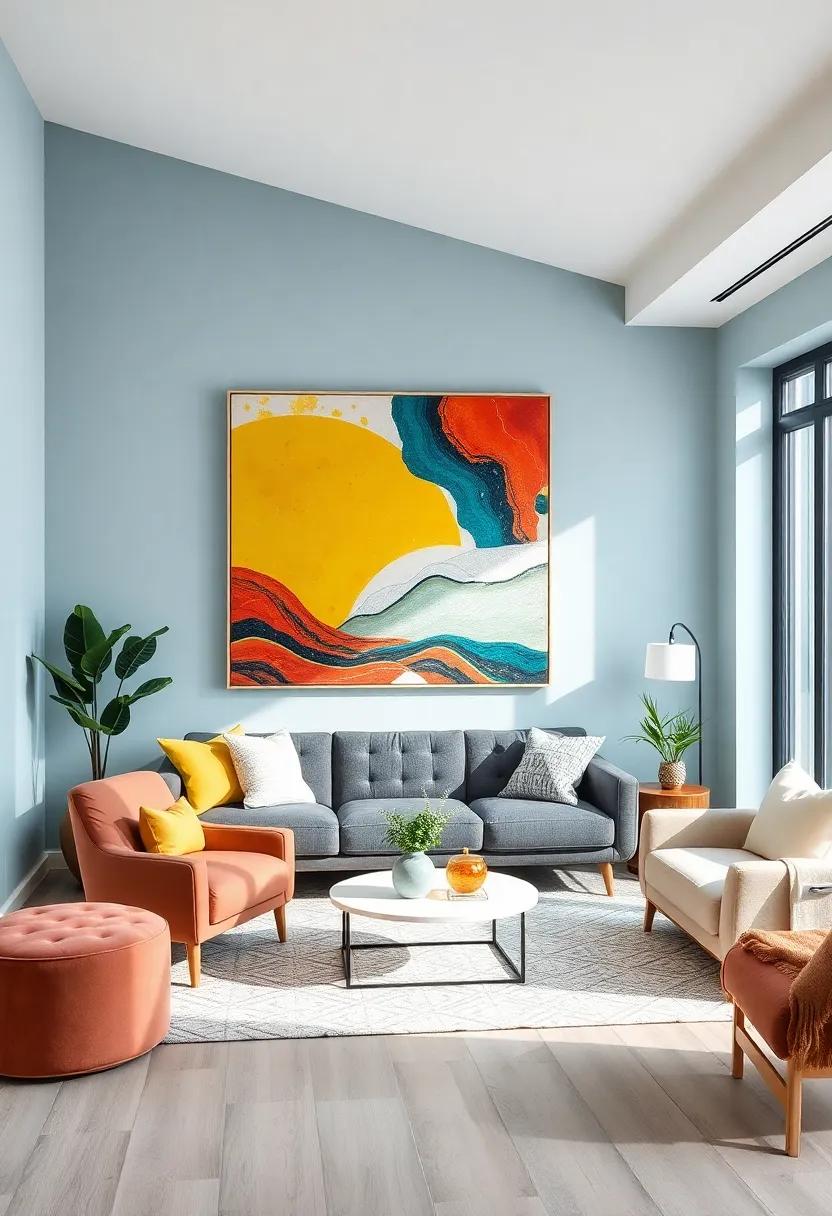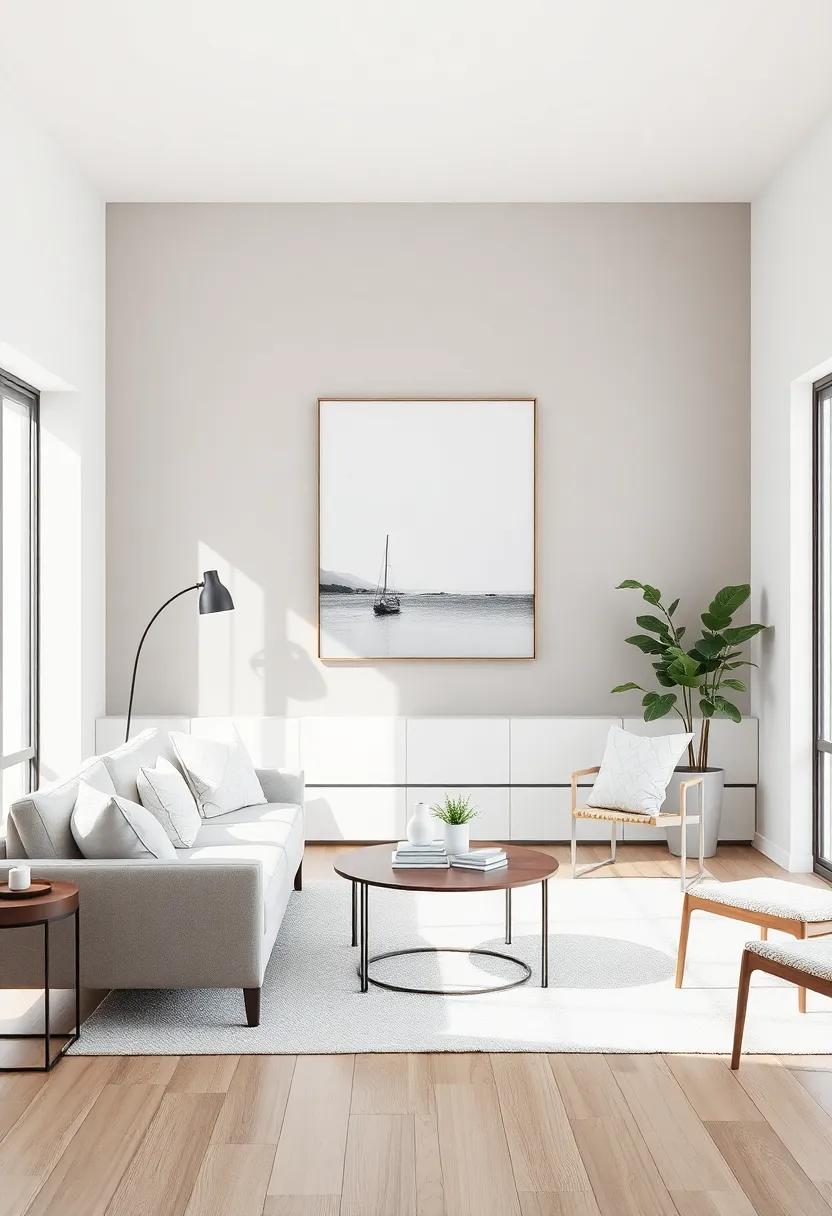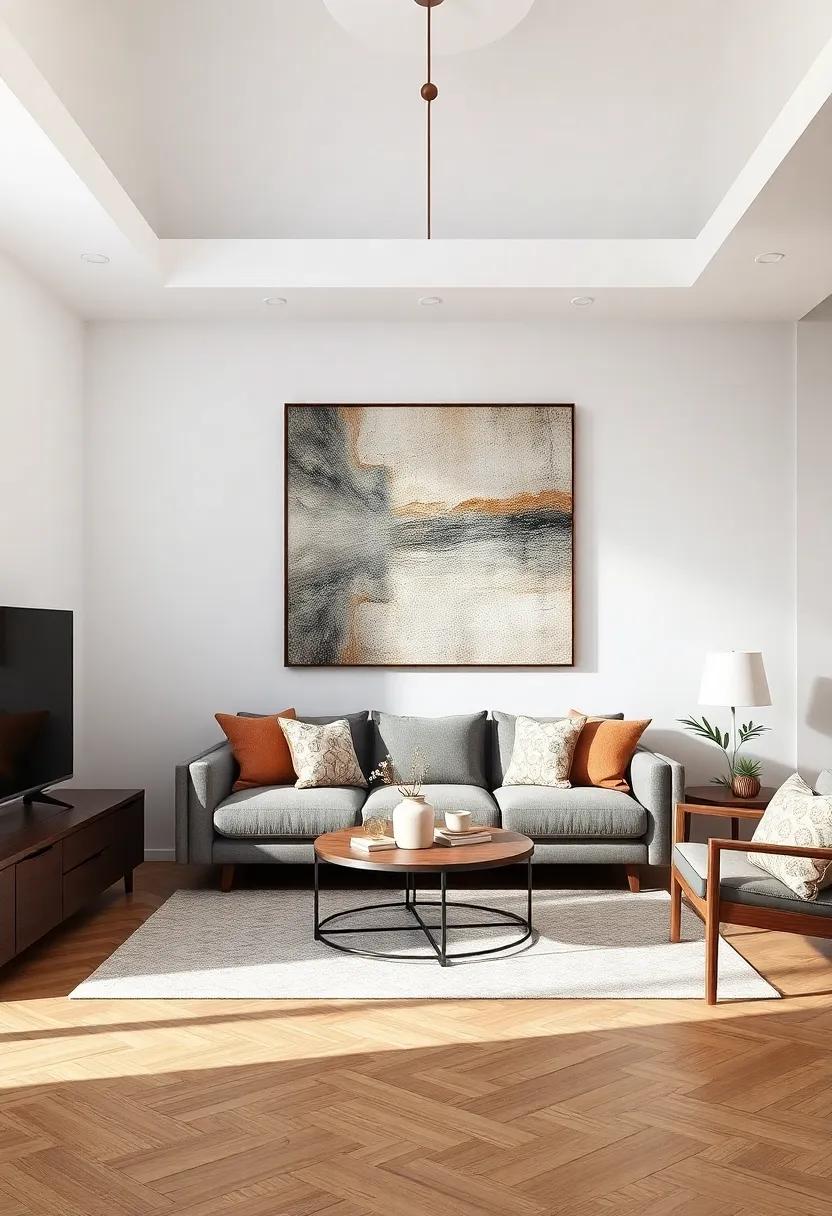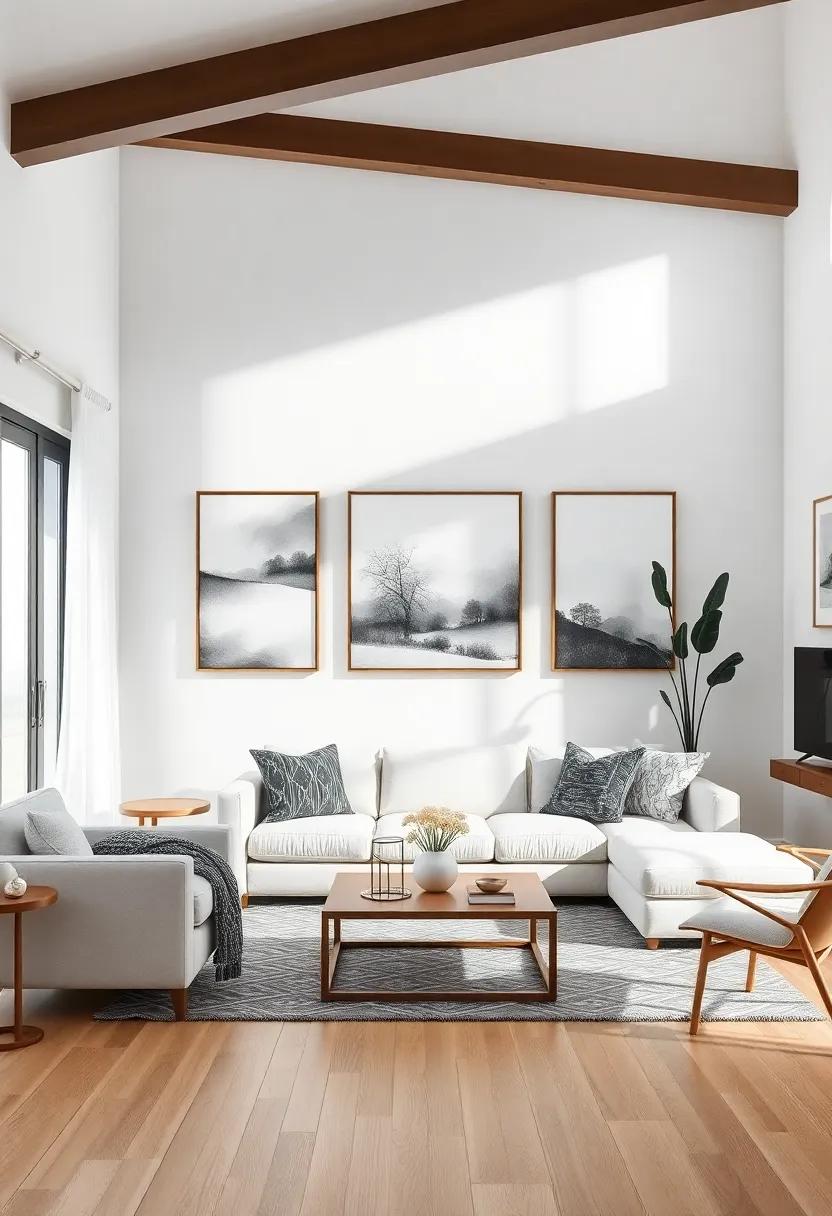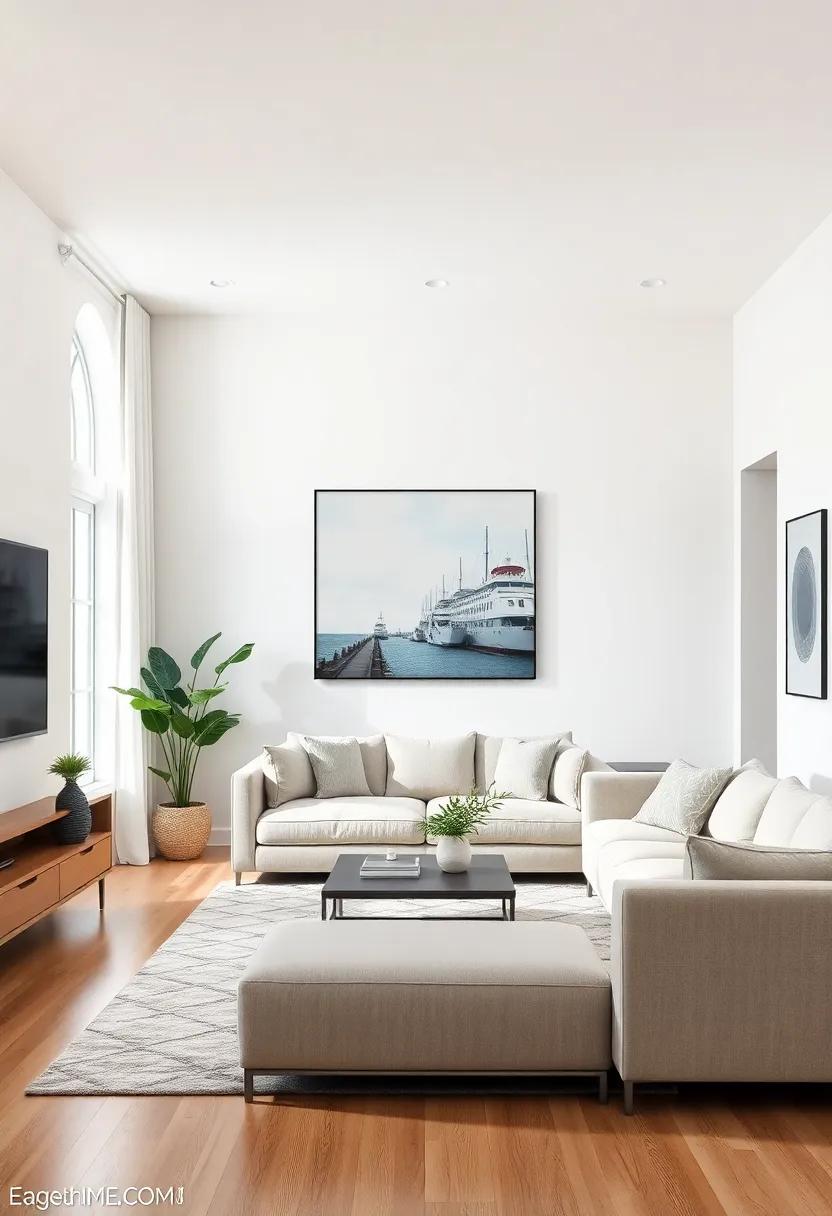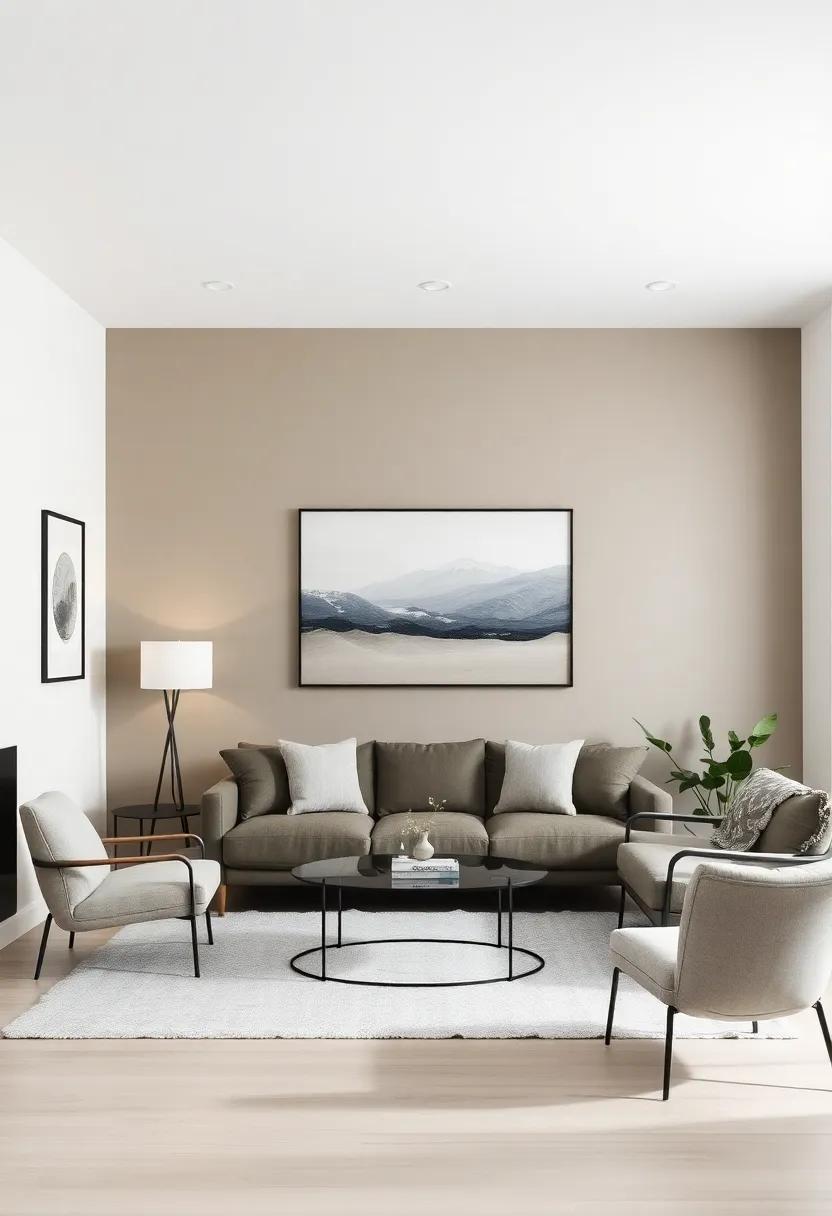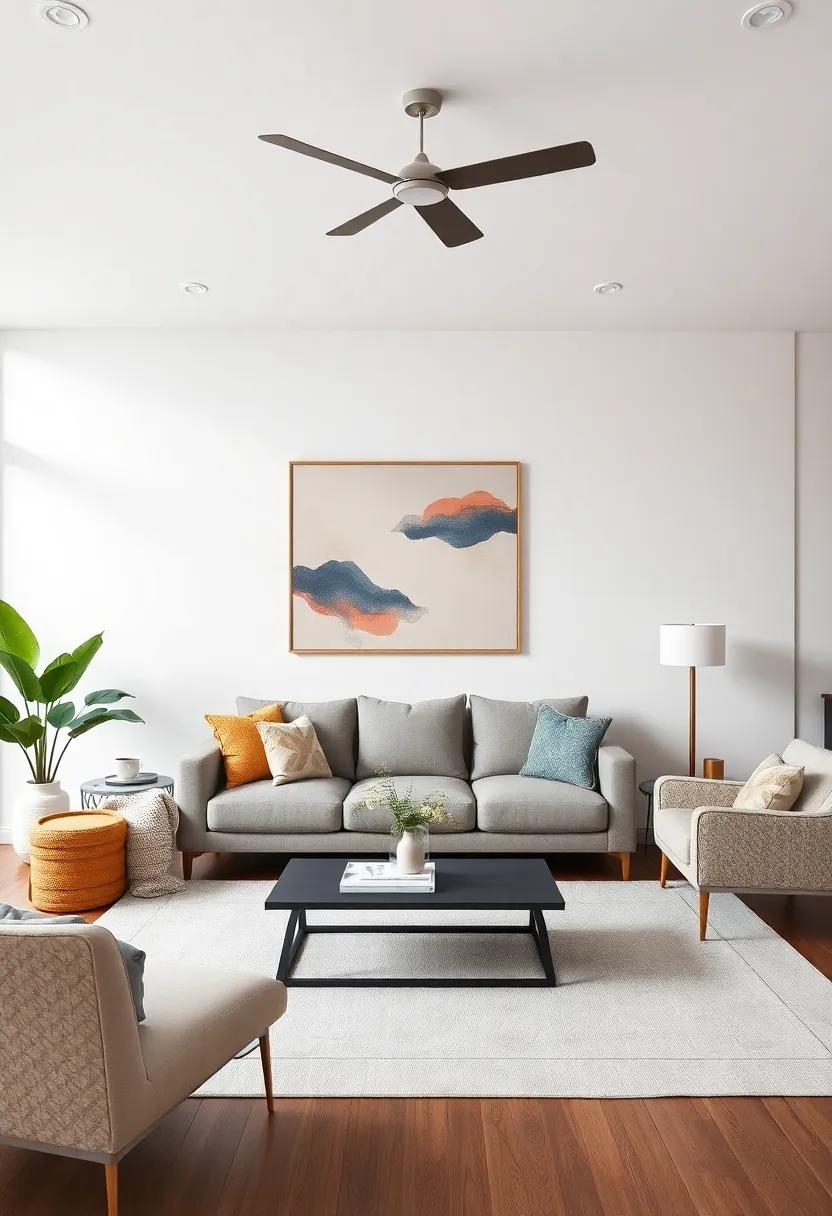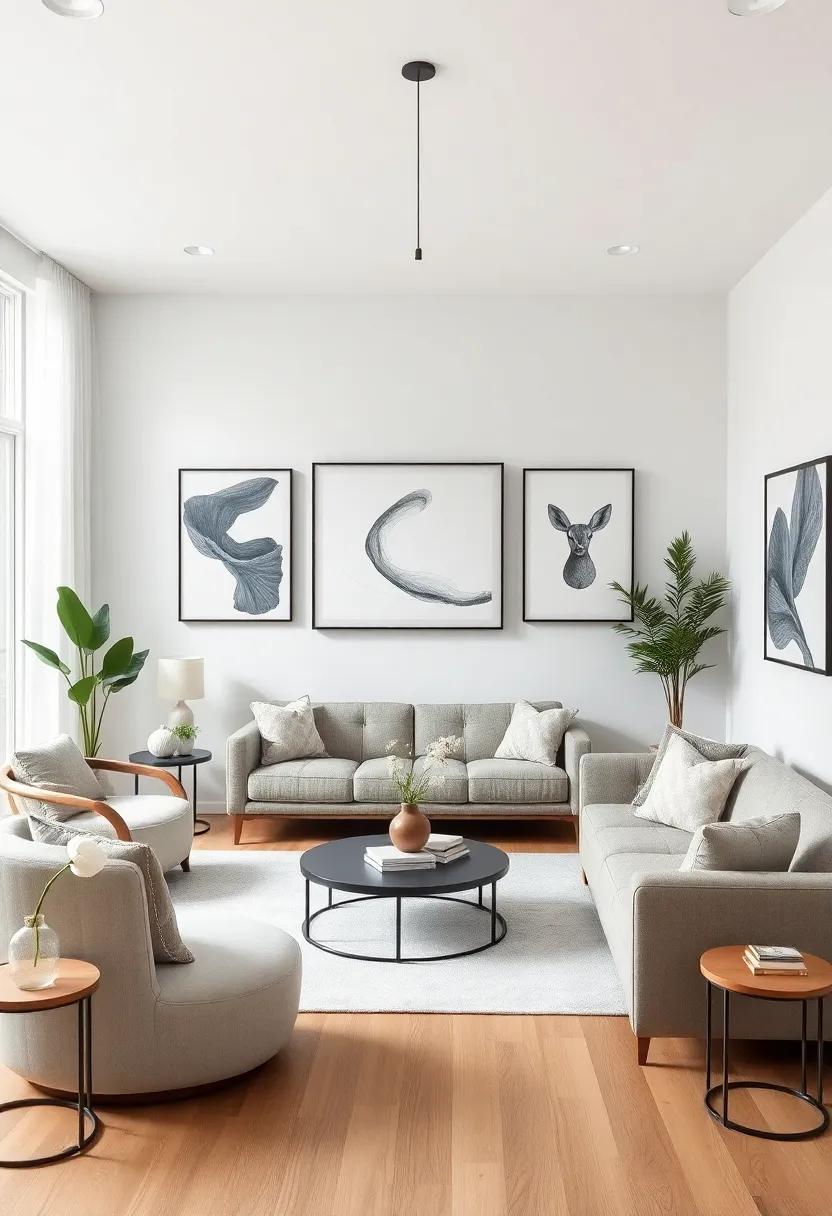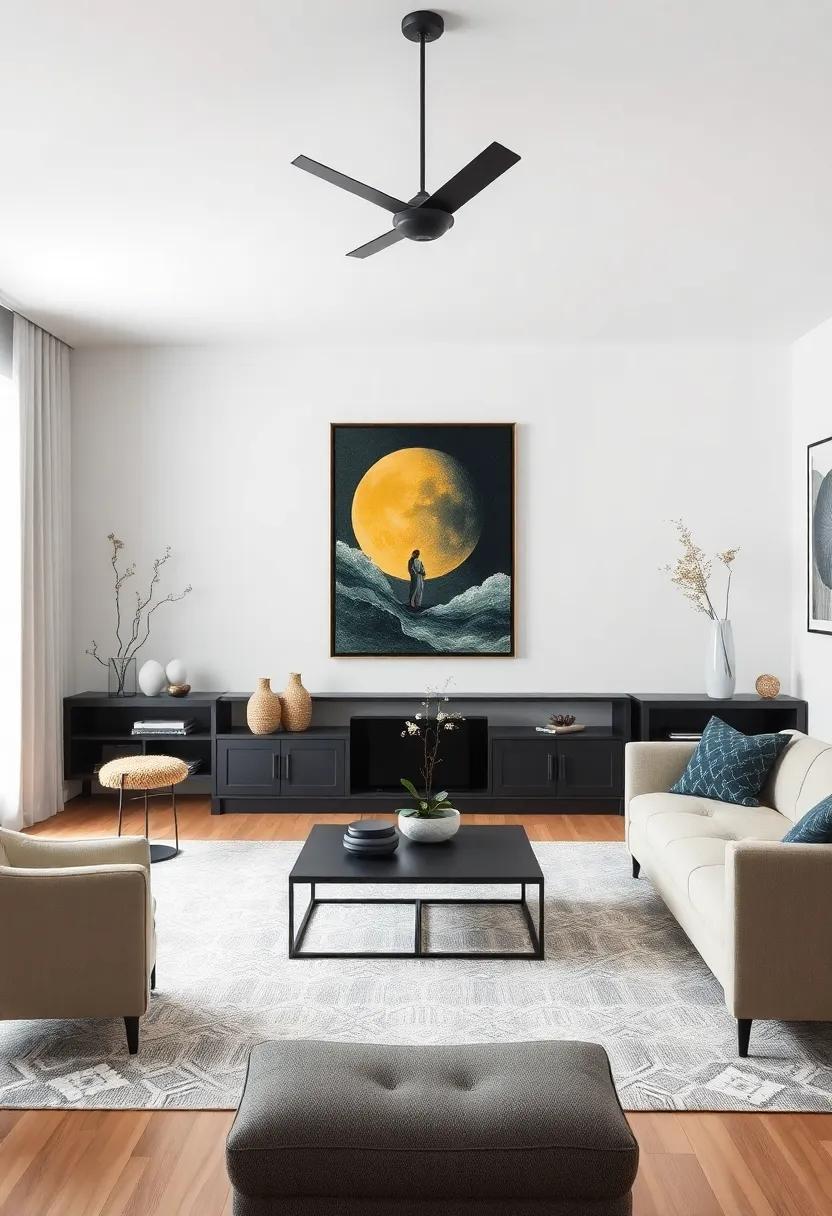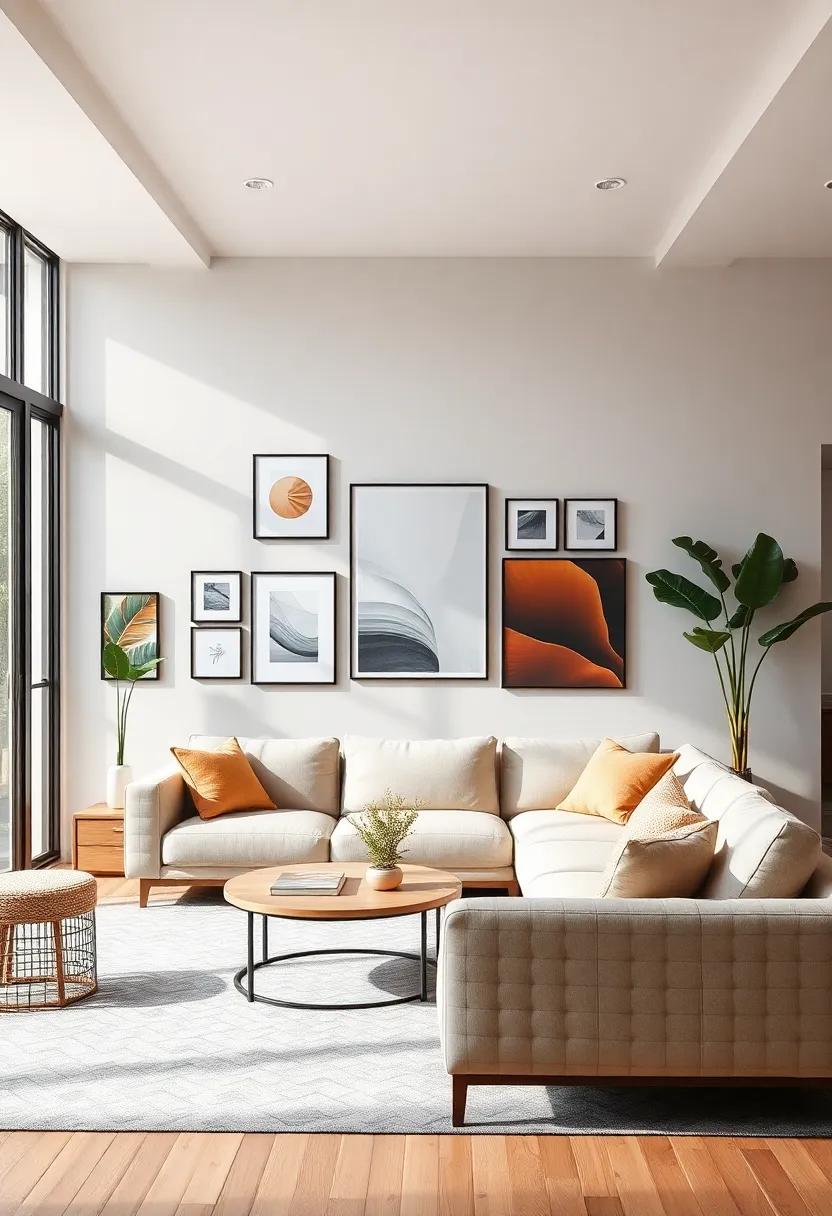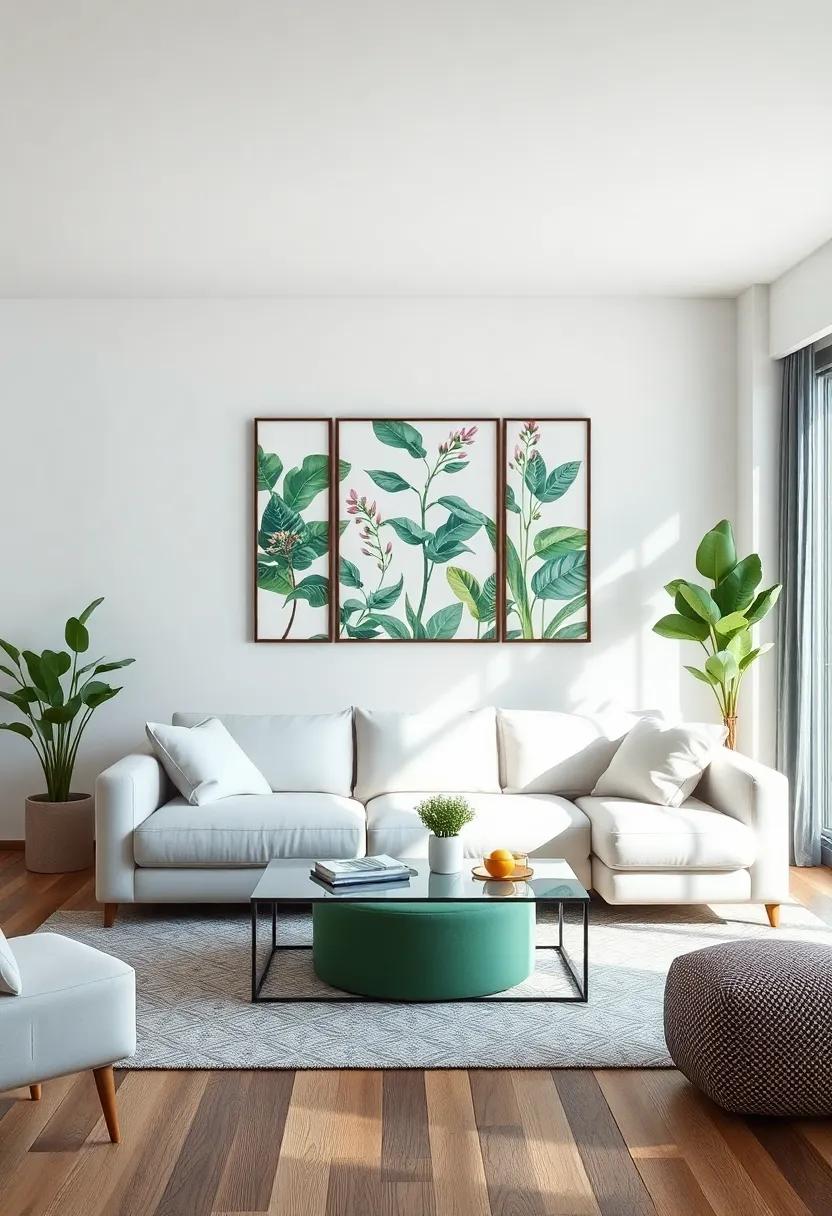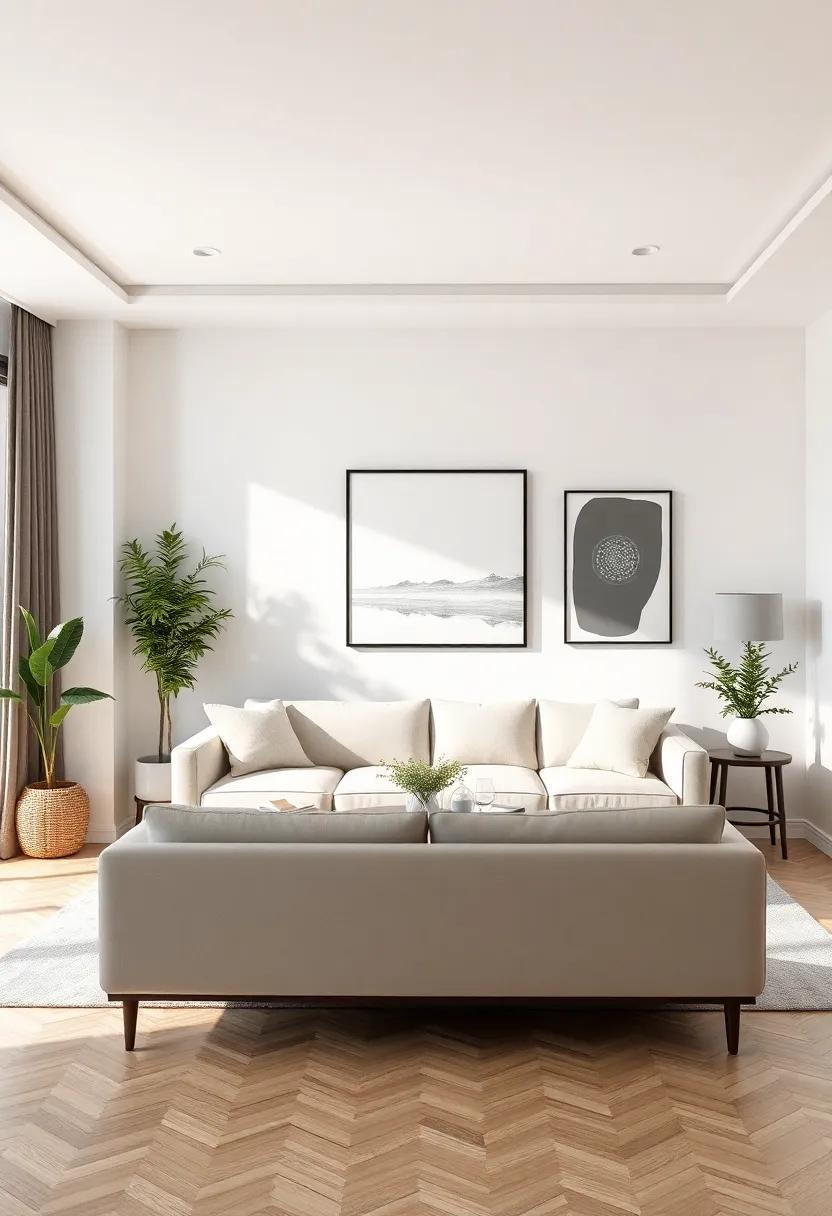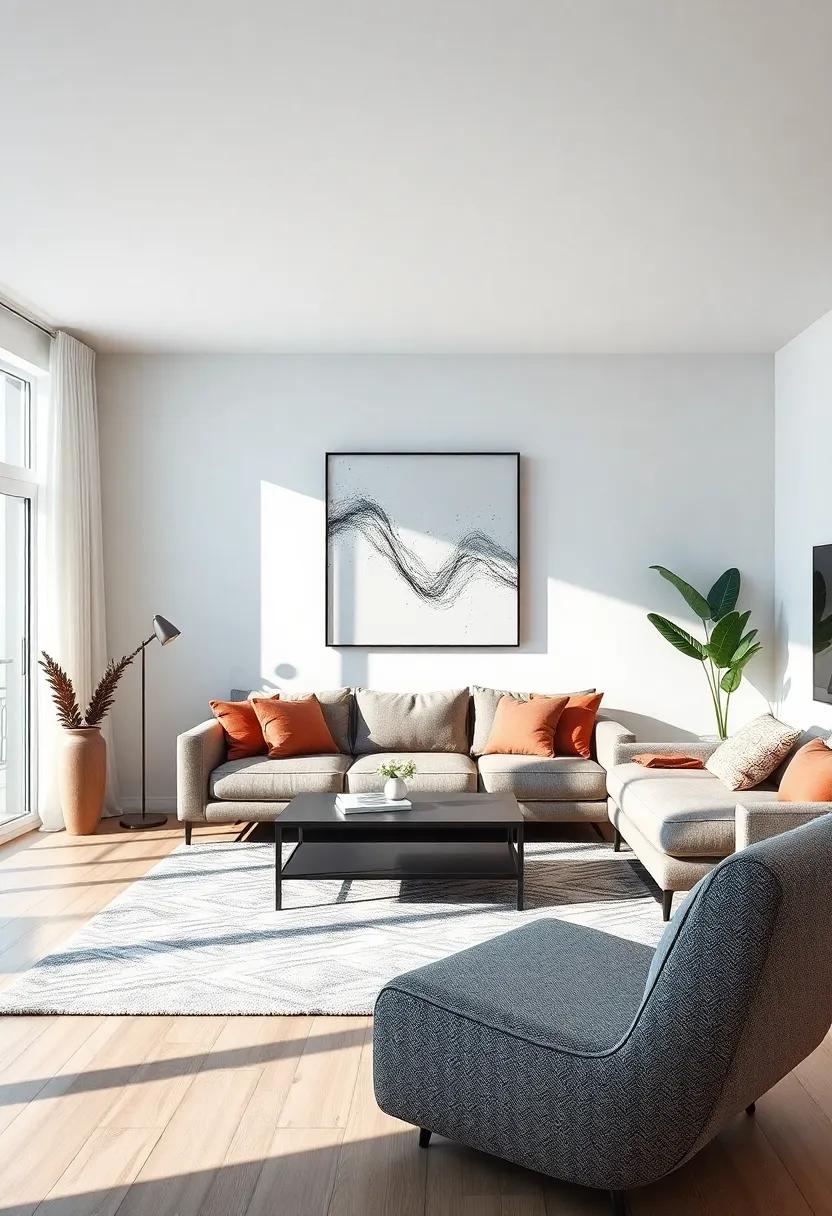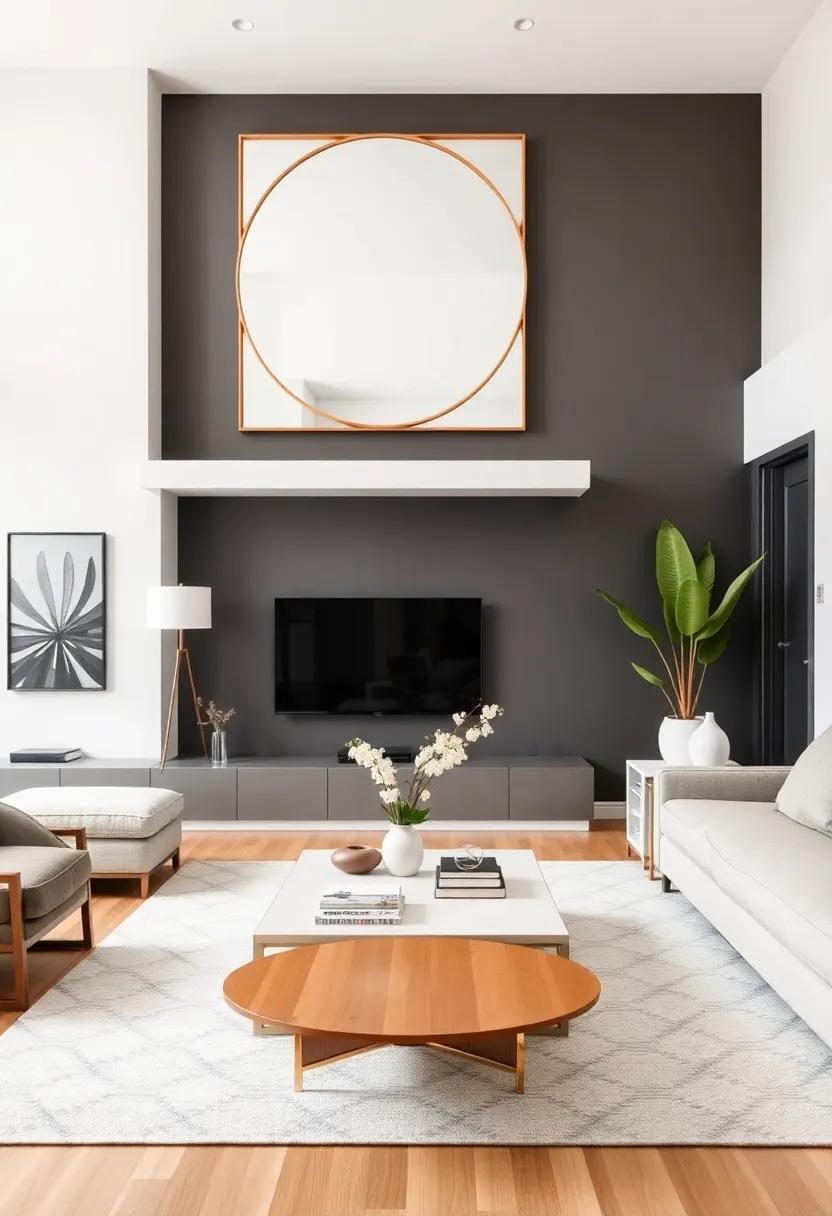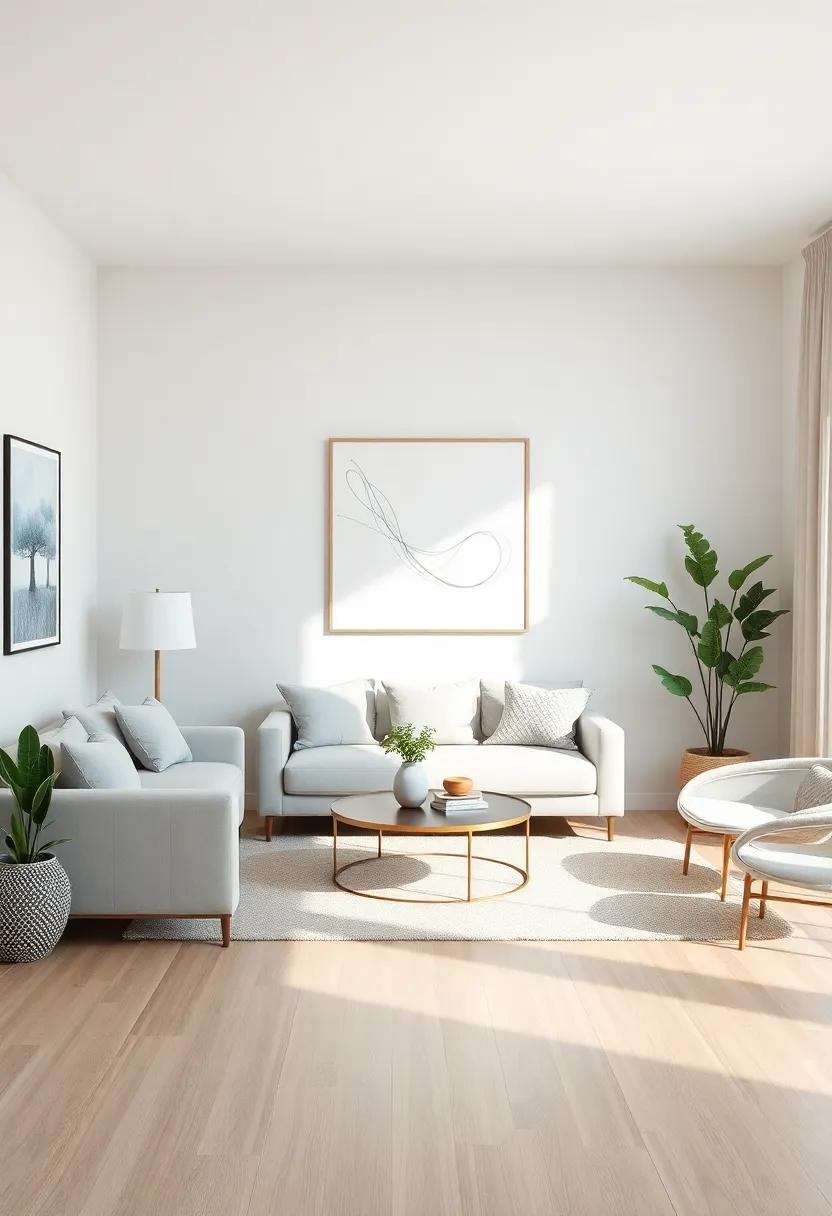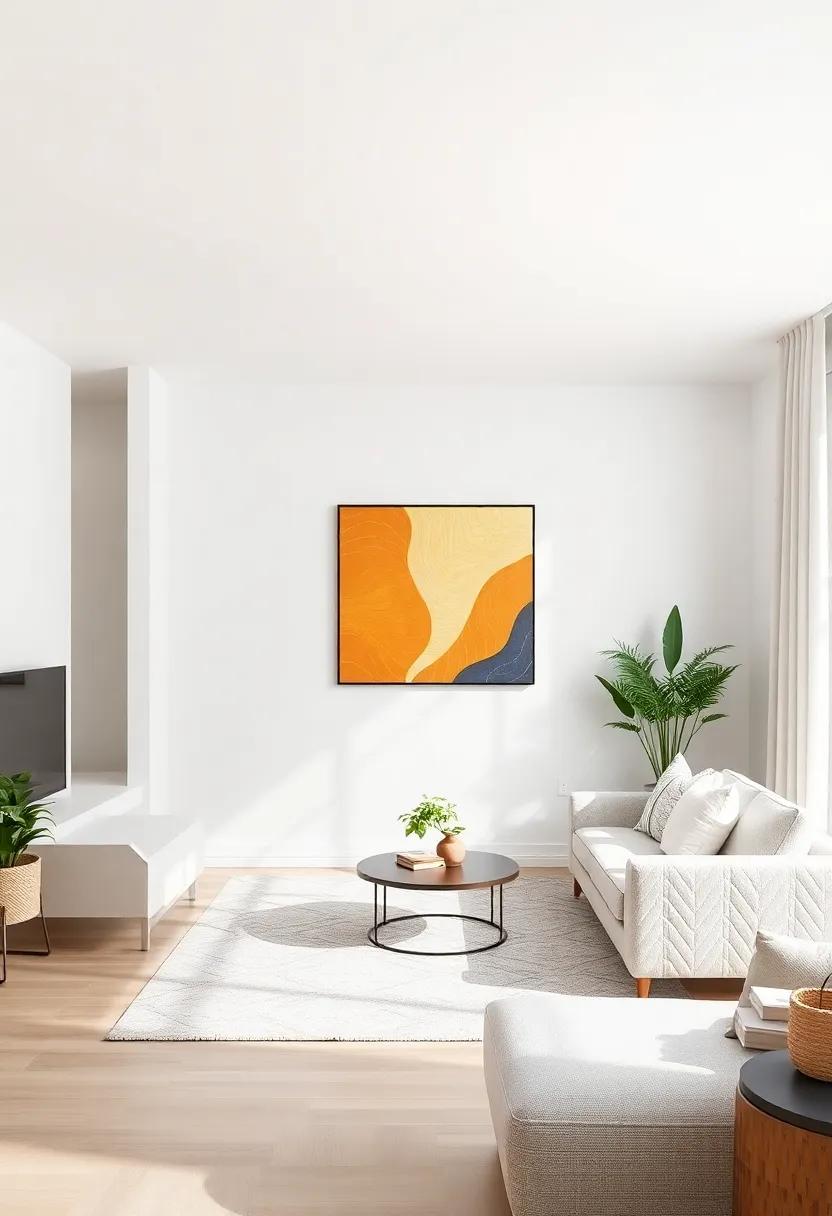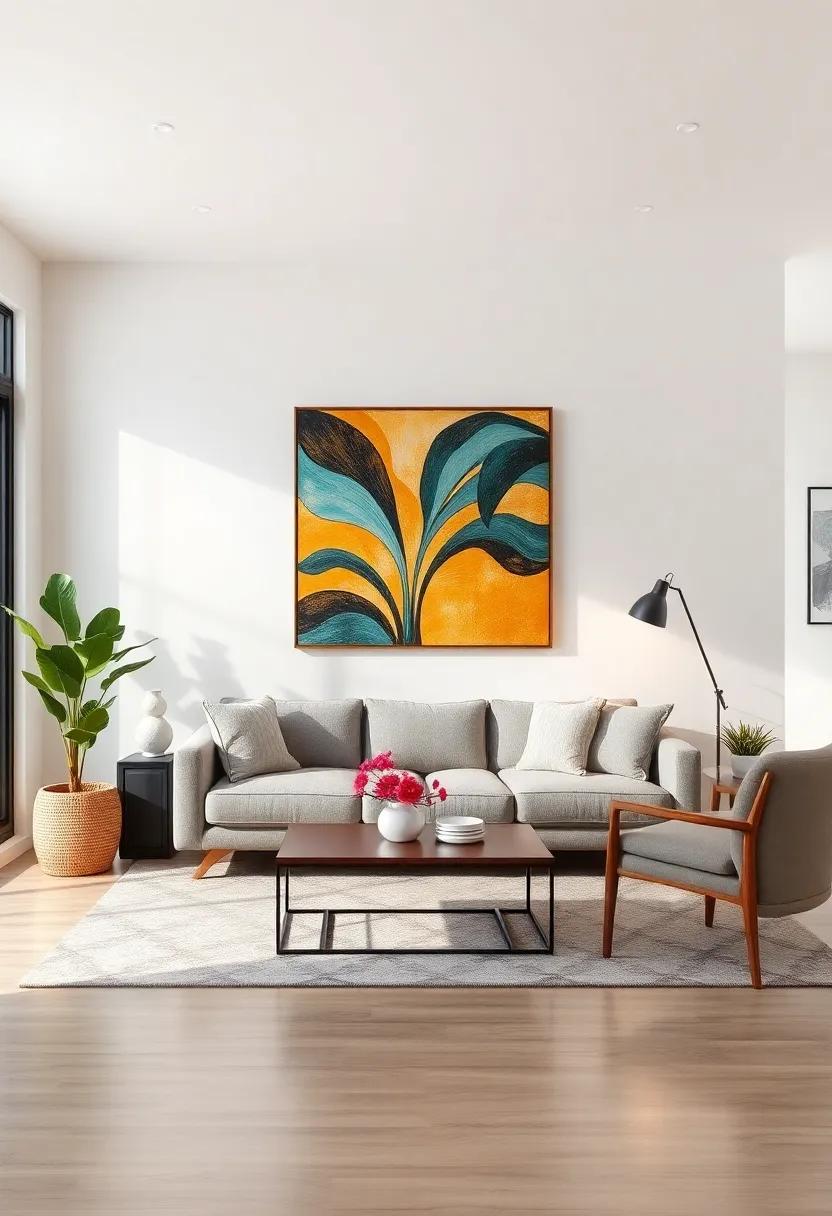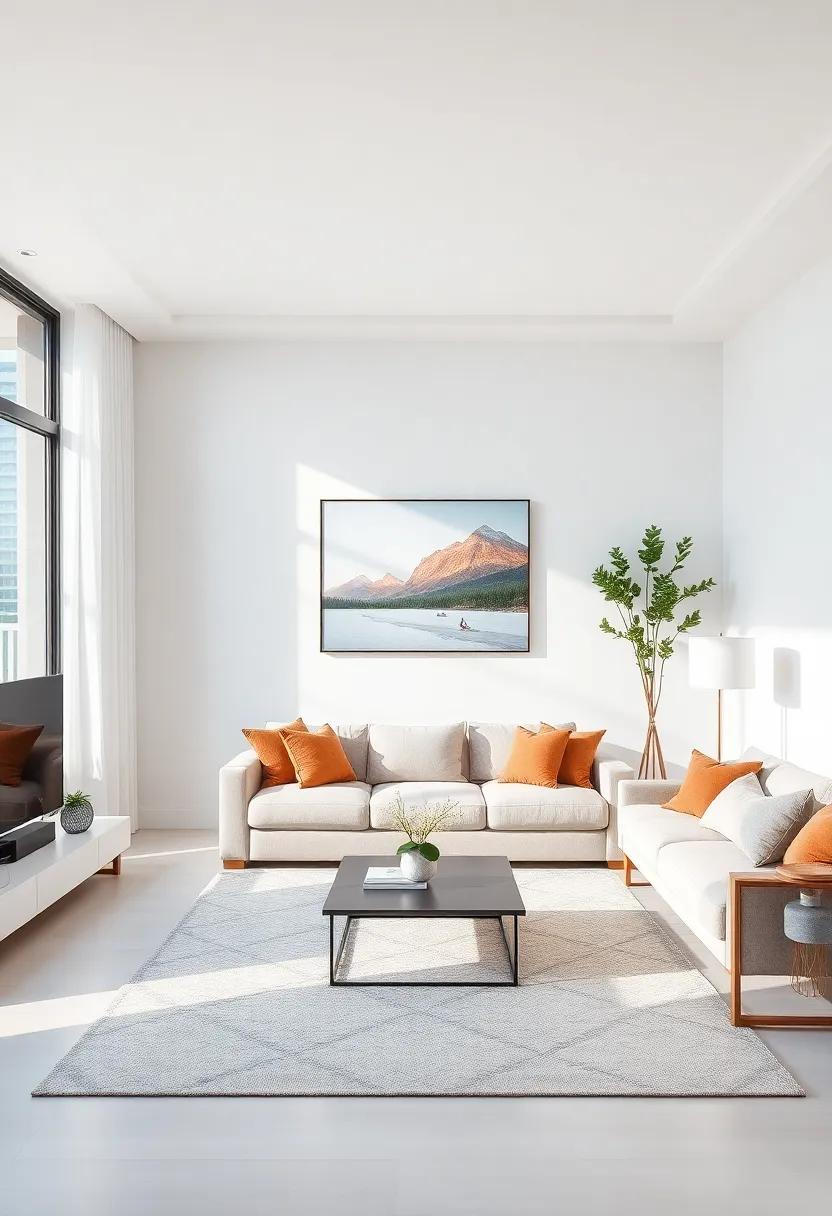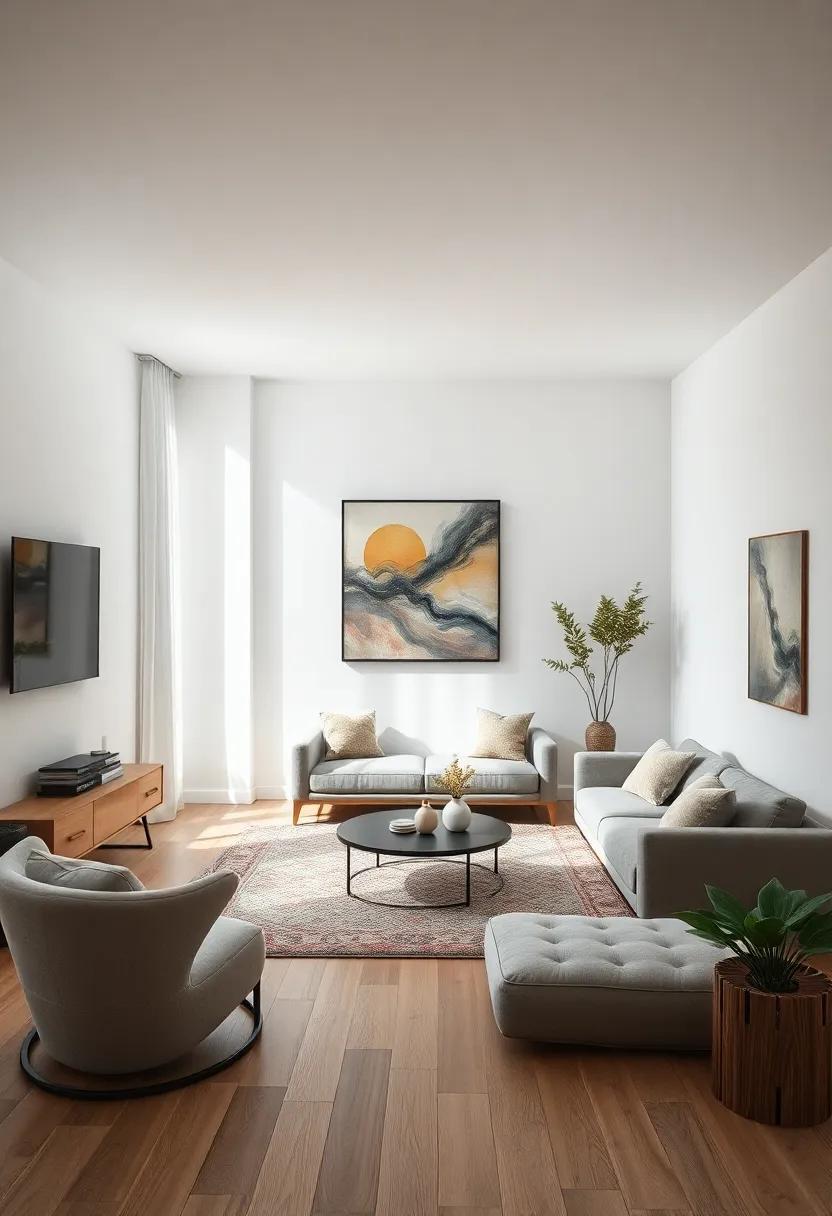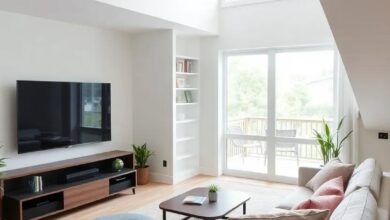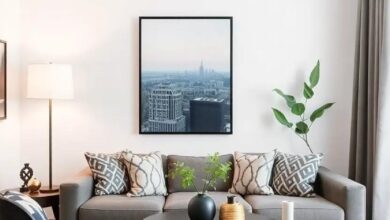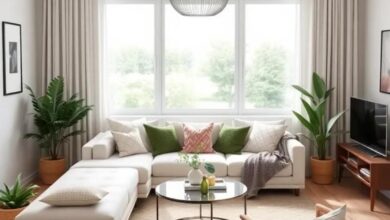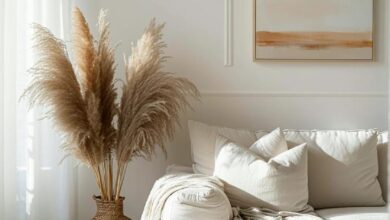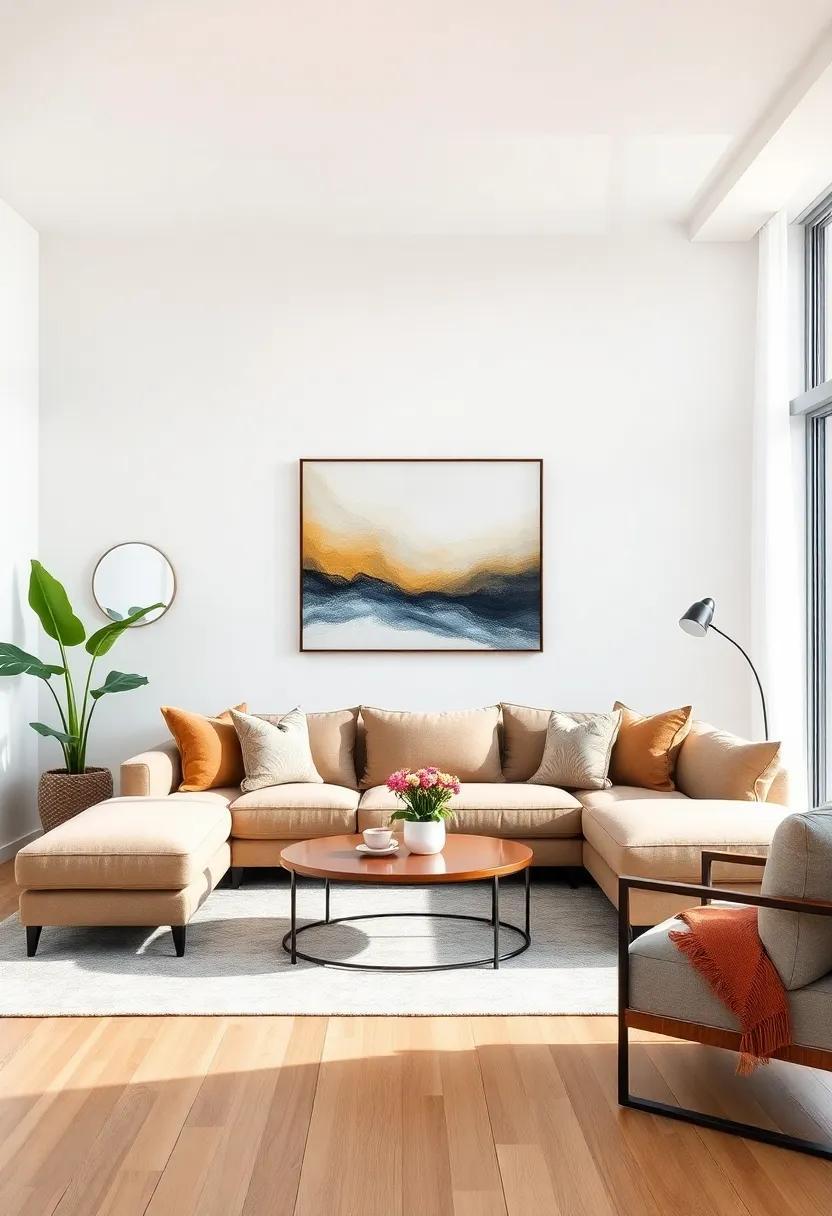
Transforming Small Living Rooms: The Power of Wall Art in Open Concept Spaces
In the realm of interior design, the small living room frequently enough poses a unique challenge, especially within the context of open concept spaces. With thier expansive layouts and seamless flow from one area to another, these environments can create a sense of ambition and potential. However, the confined square footage of a living room can sometimes feel limiting, leading homeowners to grapple with how to fully express their style while maximizing functionality. Enter wall art—a transformative element that possesses the uncanny ability to breathe life and personality into even the coziest of corners. This article explores the significant role that wall art plays in enhancing small living rooms, providing inspiration and practical tips on how to curate pieces that not only reflect personal taste but also elevate the aesthetic and emotional ambiance of open concept spaces. Join us as we delve into the creative strategies that invite beauty and inspiration into every nook,proving that even the smallest living areas can wield remarkable power through artistic expression.
Transform Your Space with Bold, Colorful Wall Art That Inspires open Concept Living
In an open concept living space, the right wall art can tie together various areas, creating a cohesive and inviting ambiance.Bold, colorful pieces elevate your interior by drawing attention and creating a focal point that encourages conversation and connection. Consider incorporating art that reflects your personal style, while also complementing the surrounding decor. Rich hues and dynamic patterns can visually enlarge the space, making it feel more expansive and alive, while also infusing energy and personality into your surroundings.
As you curate your wall art collection, think about arranging it in a way that adds depth and intrigue.Here are some ideas to inspire your creative design:
- Gallery Walls: Combine framed prints with different sizes and styles to create an eye-catching display.
- Textured Art: Use pieces with various materials, such as canvas, wood, or metal, to add visual interest.
- Color Stories: Group art in color clusters to create a harmonized look that resonates throughout the space.
To maximize the impact of your artwork,consider using floating shelves or unconventional hanging methods,allowing your creativity to shine. For more inspiration on stylish wall art and home decor design, visit Houzz.
Embrace Minimalism: Finding Harmony with subtle art in Small Living Rooms
In the pursuit of minimalism, small living rooms can bloom into serene spaces, inviting a sense of calm through carefully curated décor. Wall art plays a crucial role in this transformation, allowing homeowners to express their personality without overwhelming the room. To create visual balance, consider choosing pieces that embody subtle color palettes and simple geometric shapes. These elements harmonize effortlessly with the design of the room,emphasizing spaciousness rather than clutter. Incorporating art that reflects natural motifs, such as landscapes or botanical prints, can further connect the indoor habitat with nature, projecting tranquility and warmth.
When selecting artwork for compact areas, it’s vital to keep functionality in mind. Opt for floating shelves or gallery walls that incorporate both art and small decorative items, maximizing vertical space while maintaining an airy feel. The strategic placement of a few well-chosen pieces can draw the eye upward, creating an illusion of height. A curated art display not only serves as a focal point but also provides opportunities for conversation and connection. For inspiration and tips on minimalistic living, check out The Minimalists. Embracing these principles in a small living room can lead to a beautifully cohesive environment, perfectly aligned with a minimalist lifestyle.
Layering Textures: Combining Wall Art with Other Design Elements
Integrating wall art into your small living room opens a world of creative possibilities when paired with complementary textures and materials. Think of your walls as a blank canvas where various elements can harmonize for a cohesive design. A large canvas painting can become the centerpiece, surrounded by textured pillows on the sofa or a knit throw blanket draped over an accent chair. To further elevate the visual interest, consider mixing in metallic accents like a sleek floor lamp or a decorative mirror that reflects light and creates depth. Each layer adds a unique touch, seamlessly intertwining the artwork with the surrounding furnishings.
Experimenting with different materials can also enhance the atmosphere of your space. As a notable example, pairing soft fabric wall art with rustic wooden elements—such as a reclaimed wood coffee table or an earthy shelf—can create a balanced aesthetic. Additionally, incorporating elements like plants or ceramic vases introduces organic textures, bringing freshness and life to the room. Remember to opt for a color palette that complements both your wall art and the furniture; this will ensure the various elements don’t compete for attention but instead work in harmony. For more ideas on mixing textures and styles, you can visit Apartment Therapy.
Creating Focal Points: The Role of Wall Art in Defining Open Areas
In open concept spaces,where the boundaries between different functional areas frequently enough blur,wall art becomes a vital component in establishing distinct focal points. Strategically selected pieces can guide the eye, creating visual anchors that divide the room without the need for physical barriers. for instance, a large, vibrant painting can serve as a centerpiece above a sofa, drawing attention and making that corner feel more inviting and defined. Meanwhile, smaller collections of framed prints can be hung in a staggered fashion to lead the viewer along walls, contributing to the flow and enhancing the overall aesthetic.
To maximize the impact of wall art in your living room, consider incorporating various styles and textures that resonate with your personal taste. A diverse mix of pieces can offer depth and interest, transforming bare walls into galleries of expression. Here are some ideas to contemplate:
- Gallery Wall: Create a curated display with various frames and sizes.
- Statement Piece: Opt for one oversized artwork to act as a talking point.
- Theme Coordination: Match art styles with your room’s color palette.
By thoughtfully selecting and arranging wall art, you can not only enhance the aesthetic appeal of your small living room but also effectively define the different functionalities within an open area. Feel free to explore inspiration at Houzz to see how others have brilliantly used art to create cohesive yet vibrant living spaces.
The Impact of Scale: Choosing the Right Size Art for Small Spaces
When decorating small spaces, the scale of wall art becomes crucial in creating a harmonious and inviting atmosphere. Large pieces can overwhelm a compact living room, making it feel cramped, while too-small art can feel lost on the walls, failing to make an impact. Rather, consider medium-sized art pieces that can serve as focal points without overpowering the room. Pairing multiple smaller artworks in a cohesive gallery style can also effectively utilize vertical space while adding a personalized touch. Use varying dimensions to create interest, but be sure to maintain a unifying theme or color palette for a polished look.
Another crucial factor is the way you hang your art. Aligning art at eye level helps ensure that it draws attention while creating a balanced arrangement. Additionally, integrating floating shelves or art ledges allows for adaptability, enabling you to easily update your display as your style evolves. Remember to play with textures and layering; combining two-dimensional artworks with three-dimensional elements can bring depth to a small area. Ultimately, the key is to choose pieces that reflect your personality while enhancing the overall design of your open concept space. For more tips on art placement,visit artsy.net.
Color Psychology: Selecting Wall Art That Elevates Mood and Feelings
Choosing the right colors for your wall art can substantially influence the ambiance of your small living room,especially in an open-concept space. Colors play an essential role in evoking emotions, and certain hues can create an inviting and uplifting environment.For instance, warm colors like reds, oranges, and yellows can spark energy and excitement, making the room feel vibrant and alive. In contrast,cool colors such as blues and greens emanate calmness and tranquility,perfect for those seeking a serene refuge. Combine these colors thoughtfully; a pop of warm art can add a lively contrast to a predominantly cool palette, achieving a balanced emotional response.
When selecting wall art, consider not only the color but also the subject matter and style. Abstract art can invoke curiosity and inspire conversation, while landscapes might provide a sense of peace and grounding. Here are a few ideas to keep in mind when choosing wall art to enhance your living space:
- Personal Connection: Choose pieces that resonate with your experiences or values.
- Size Matters: Select artwork that complements the scale of your furniture for harmony.
- Layering Textures: Incorporate different materials to add visual depth; think canvas, metal, or fabric.
- Groupings: Create a gallery wall with various pieces for dynamic interest.
For a better understanding of how colors influence feelings, consider exploring resources like Color Psychology. An informed approach to selecting wall art not only elevates the mood of your living room but also reflects your personality and style, turning your space into a personalized sanctuary.
Eclectic Styles: Blending Different Art Forms in an Open Concept Space
In open concept spaces, the freedom to blend various artistic expressions can transform a living room into a vibrant tapestry of creativity. Imagine combining abstract paintings with sculptural elements, allowing each art form to complement and contrast with the other. Such a mix invites visual intrigue and stimulates conversation. wall art can serve as a focal point that weaves together themes from multiple mediums—think bold colors from a painting echoing the shapes of a ceramic sculpture or textured wall hangings harmonizing with photographic prints. This eclectic style not only enhances individual pieces but also creates cohesive narrative threads throughout the space.
To effectively incorporate different art forms, consider alternating visual weights and textures across the wall. Create designated zones using a balance of framed pictures, floating shelves lined with small sculptures, and wall-mounted textiles. here are a few impactful combinations to explore:
- Large abstract canvas paired with a minimalist wood sculpture
- Vibrant mural complemented by metal wall accents
- Black and white photography alongside colorful textile art
Experimentation is key, as creating a visually dynamic environment is often about breaking customary rules. Use inspiration from resources like designboom.com to explore examples of rooms that successfully merge styles, guiding your own design journey.
Framing Your World: Creative Solutions for Displaying Wall Art
When it comes to displaying wall art in a small living room,creativity is your best ally.Consider using multipurpose frames that not only enhance the aesthetic appeal but also serve practical functions. Here are some imaginative ideas to elevate your wall spaces:
- Gallery Wall: Create a stunning gallery wall using a mix of frame sizes and styles. This collage-like display can make a visual impact while drawing the eye upward, giving the illusion of height.
- Floating Shelves: Install floating shelves to showcase art alongside decorative objects like plants or books. This layered approach adds depth and character to the walls.
- Art Ladders: Use a stylish ladder as a stand for vertical art pieces. This unconventional display method not only saves space but creates a rustic charm.
Another effective strategy is to embrace color and texture through your art choices. Select vibrant pieces that can act as focal points, harmonizing with your overall decor. Here’s a simple table to illustrate the potential impact of color in wall art:
| Color | Effect on Space |
|---|---|
| Warm Tones | Creates an inviting and cozy atmosphere. |
| Cool Tones | Evokes calmness and can make a space feel larger. |
| Neutral shades | Provides versatility and balance to any decor style. |
For more inspiration on creative art displays, check out Apartment therapy.
personal Narratives: Using Custom Art to Showcase Your Story
Every small living room has potential waiting to be unleashed, and incorporating custom wall art can transform your space into a personal canvas that tells your unique story. Whether it’s a stunning landscape that evokes cherished memories of travels or abstract pieces that reflect your personality,each artwork serves as a focal point. By curating a collection that resonates with your experiences,you not only enhance the aesthetic of your living space but also create an inviting atmosphere that sparks conversation. Think of your walls as a gallery where each piece speaks volumes about who you are.
To maximize the impact of your wall art in an open-concept space, consider the following tips:
- Choose a Theme: Whether it’s travel, nature, or abstract, consistency can unify your space.
- Mix Dimensions: Combine framed pieces with canvas art for a dynamic display.
- Balance Colors: Ensure that your art complements the existing color palette of your room.
Utilizing features like a gallery wall can also help define different areas within an open layout, allowing you to create distinct atmospheres while maintaining a cohesive look. By showcasing personal narratives through custom art, you infuse your small living room with character and warmth, making it truly your own. For more inspiration on home decor ideas, check out Houzz.
Gallery Wall magic: Arranging Art for Maximum Visual Impact
Creating a gallery wall is an art in itself, inviting a rhythm of colors, shapes, and textures into your living space. To maximize visual impact, start by selecting a cohesive color palette that resonates with the existing décor. Mixing sizes and frame types can add dynamism, so consider incorporating the following elements:
- Mix media: Paintings, photographs, prints, and 3D objects.
- Vary the frame styles: From sleek modern to rustic vintage.
- Play with scale: Integrate both small and large pieces to create contrast.
Once you’ve gathered your collection, planning the arrangement is essential. Lay everything out on the floor first, allowing you to visualize how the pieces interact. Think about a focal point to anchor your gallery wall—perhaps a larger artwork or an eye-catching sculpture. Additionally, remember that the height at which pieces are hung can significantly effect perception; aim for a cozy viewing level, typically around eye level. For inspiration and further tips, check out Apartment Therapy for creative ideas on maximizing your wall space.
Nature’s Touch: Incorporating Botanical Prints for Fresh Ambiance
Botanical prints breathe life into small living rooms, creating a vibrant and fresh ambiance that resonates with the simplicity of nature. Incorporating these prints not only serves as a visual delight but also connects the indoor space with the lushness of the outdoors. For a harmonious effect, consider layering different types of botanical artwork, such as:
- Framed Botanical Illustrations: Classic and educational, these pieces add a vintage charm.
- Textured Plant Motifs: Options such as canvas or fabric prints offer depth and warmth.
- Large Scale Wall murals: Create a focal point that transforms the ambiance entirely.
When arranging your botanical prints, it’s essential to ensure they harmonize with the rest of your decor. A cohesive color palette will tie together the prints with your furniture and accessories,providing a seamless transition from one area to another. Utilize groupings that vary in size and orientation to add visual interest, while considering factors such as:
| Element | Impact on Ambiance |
|---|---|
| Color scheme | Creates emotional responses and sets the mood. |
| Print size | Affects the perceived scale of the room. |
| Framing style | Influences the overall aesthetic and decor theme. |
Explore more tips on creating serene spaces with nature’s essence at Apartment Therapy.
Transforming Blank Walls: Strategies for Filling Negative Space Effectively
When grappling with the challenge of vast blank walls in small living rooms, consider employing a mix of art styles and arrangements to bring your space to life. Start by selecting a focal piece—an oversized painting or an eye-catching mural that draws the eye and sets the tone for the room. Surround this central artwork with other items to create a gallery wall effect. You can incorporate a variety of elements, such as framed photographs, quirky sculptures, or textiles, to add depth and intrigue. Mixing different textures and colors can create a whimsical yet harmonious environment that enlivens your space.
To maximize the impact of wall art while ensuring a cohesive feel throughout your open-concept area, consider these practical strategies:
- Layering different sizes of artwork to create visual interest.
- Utilizing shelving to display both art and decorative objects, which provides functionality alongside aesthetics.
- Rotating art seasonally to keep your decor fresh and exciting.
- Incorporating mirrors, which can reflect light and make the space appear larger.
By thoughtfully choosing and arranging wall art, you can transform empty spaces into curated sections of personality and charm. For more inspiration on elevating your interiors with art, visit Apartment Therapy.
Light and Shadow: How Wall Art Alters Perception in Small Living Rooms
In the realm of interior design,wall art serves as more than just decoration; it plays a crucial role in shaping the atmosphere of compact living spaces. The interplay between light and shadow can dramatically alter how a room feels, particularly when the walls are adorned with thoughtfully chosen pieces. High-contrast artworks, as a notable example, create striking shadows that can lend depth to an or else flat space. Opting for large-scale pieces or a well-arranged gallery wall can draw the eye upward, tricking the mind into perceiving a room as taller and more expansive. When natural light filters through windows, it dances across textures and colors, breathing life into the art and, consequently, the room itself.
Additionally, the color palette of your wall art can significantly influence mood and perception in a small living room. Lighter tones can make the space feel airy and open, while darker hues may provide a cocooning effect that adds warmth and intimacy. Incorporating reflective materials like metallic frames or glossy finishes can enhance brightness by bouncing light around the room, while matte surfaces may absorb it, bringing a sense of calm. To optimize the illusion of space, consider art that features perspective or dimensionality, drawing the viewer’s eye deeper into the composition. Embrace the transformative potential of art to not only beautify your living area but also reshape your experience within it. For further inspiration on how to select the perfect pieces, visit Architectural Digest.
Incorporating Mirrors: Enhancing Art Display and Making Spaces Feel Larger
mirrors serve as an excellent tool for enhancing art display and creating an illusion of space in smaller living rooms. By strategically placing mirrors opposite or adjacent to your wall art, you can amplify both the visual impact of the artwork and the overall brightness of the room. The reflective quality of mirrors not only draws the eye but also brings depth to the room, making it feel more expansive. Consider these placement tips for maximum effect:
- Position mirrors at eye level to create a dynamic focal point that complements your art.
- Choose framed mirrors that harmonize with your wall art style for a cohesive look.
- Utilize large, statement mirrors to act as standalone art pieces themselves.
Additionally, mirrors can be utilized to reflect light sources, enhancing the overall ambiance of the space. to further optimize their functionality,here’s a brief overview of how different types of mirrors can transform your living area:
| Mirror Type | Effect on Space |
|---|---|
| Wall Mirrors | Creates depth and enhances wall art visibility. |
| Statement mirrors | Acts as a bold feature piece, adding character. |
| Clustered Mirrors | Gives a modern twist, adding variety and movement. |
For further inspiration on how to effectively incorporate mirrors in your interior design, consider visiting Apartment Therapy for expert tips and ideas.
Seasonal Decor: Rotating Wall Art for Year-Round Freshness
One of the most effective ways to breathe new life into your small living room throughout the year is by embracing the concept of rotating wall art. This approach not only keeps your space feeling fresh but also allows you to celebrate the changing seasons and holidays in your home decor. By curating a collection of seasonally-themed art, you can easily switch pieces to reflect the mood of each season, creating a dynamic environment that evolves with the calendar. Consider incorporating a mix of photography, prints, and original artwork that resonates with seasonal colors and themes.
To facilitate this transition, you might create a dedicated space for storing your collection. Here are some ideas for your rotating gallery:
- Framed Seasonal Prints: Invest in high-quality, interchangeable frames that allow for easy swapping.
- Themed Displays: Use small shelves or ledges to display seasonal decor items alongside your wall art.
- DIY Artwork: Have fun with family by creating seasonal paintings or crafts that you can proudly display.
Additionally, consider arranging your wall art in a way that allows for easy rotation. A gallery wall can be organized with clips or magnet frames,making it simple to swap out artwork as needed. For more inspiration on wall decor ideas, check out Apartment Therapy.
Creative displays: Unconventional Ways to Hang and Showcase Wall Art
elevating your small living room through creative wall art displays can be a game-changer. Here are some unconventional methods that can transform blank walls into stunning focal points:
- Gallery Ledges: Install narrow shelves to display art pieces, allowing for easy rotation and a layered look.
- Clipboards: Use clipboards to hang a rotating collection of artwork. This makes changing the art a breeze!
- Hanging Grids: Utilize wire grids or grids made with wooden frames to hang multiple pieces of varying sizes for an eclectic vibe.
- Mixed Media Art: Combine 2D art with 3D elements such as plants, sculptures, or decorative items to create a visually appealing collage.
Consider creating an interactive experience with your wall art using these ideas:
| Display Idea | Benefit |
|---|---|
| Floating Frames | Creates a sense of depth and dimension. |
| Magnetic walls | Allows for easy swapping and repositioning of art. |
| Framed Mirrors | Enhances light and makes the space feel larger. |
| Textile Hangings | Adds warmth and texture to your decor. |
These techniques not only enhance visual interest but also invite personal expression into your small living space. For more inspiration on wall art displays, visit Design*Sponge.
Play with Patterns: Using Art to Create Visual Interest and Depth
Incorporating patterns into your wall art can transform the ambiance of a small living room, adding layers of visual intrigue and depth. By layering various artworks, you invite an exploration of shapes and colors that can create a rhythmic sense of flow. Consider mixing geometric patterns with organic motifs to achieve a harmonious yet dynamic display. You might curate a gallery wall that features:
- Framed fabric wall hangings with vibrant designs
- Large canvas prints that play with abstract patterns
- Smaller artworks in contrasting textures, such as metal or wood
Utilizing a cohesive color palette can help unify diverse patterns and ensure they complement your space rather than overwhelm it. Don’t hesitate to experiment with different scales and arrangements,as this can significantly affect the perception of space. For instance, a large statement piece above a sofa can draw the eye upward, making the room feel more expansive. A table below can support more delicate designs, such as:
| Art Type | suggested Size | impact |
|---|---|---|
| Canvas Print | 36″x48″ | focal Point |
| Framed Prints | 16″x20″ | layered Interest |
| Textile Art | 30″x60″ | textural Contrast |
By thoughtfully selecting and arranging these pieces, you can craft a visually stimulating environment that reflects your personality and enhances the room’s overall aesthetic. For further inspiration on the importance of wall art in interior design, visit Design Magazine.
Wall Art as a Conversation Starter: Engaging Guests in Open Spaces
Wall art possesses a unique ability to ignite conversation,drawing guests into the narrative of your space. A thoughtfully chosen piece can act as a focal point, prompting inquiries and stories that create connections among visitors. Such as, a vibrant abstract painting may inspire discussions about art styles, while a vintage photograph can evoke memories and inspire tales of travel and nostalgia. Positioning these artworks in open spaces encourages spontaneous dialog, ensuring that your living room serves not just as a gathering area, but as a platform for interaction and bonding.
To enhance the potential for engaging conversations, consider incorporating various elements in your wall art selections:
- Diverse Styles: Mix contemporary pieces with traditional artifacts to spark contrasting perspectives.
- Local Artists: Showcase art from local creators to foster community pride and support.
- Personal Touch: Include family photos or meaningful souvenirs that carry personal stories.
Creating an environment where guests feel invited to explore and share can transform the dynamics of your living room. To maximize the impact,think about practical placements—hanging artwork at eye level and grouping smaller pieces together can create a gallery-like effect. ultimately, your wall art choices will not only beautify your space but also enliven conversations that linger long after the visit. For more ideas on how to curate meaningful wall art, check out Houzz.
Art and Functionality: Combining Aesthetics with Practical design Elements
In a small living room,each element needs to pull double duty,offering both style and utility.Wall art serves as a perfect example of this approach, bringing life to the space while also providing a backdrop that can unify disparate design elements.choosing pieces that have multiple layers of meaning or tell a story can create focal points that generate conversation,thereby enhancing the overall aesthetic while reinforcing a sense of functionality. Think beyond traditional decor; consider wall-mounted shelves that can display both framed artworks and books, effectively creating a rich, multidimensional gallery that’s both beautiful and functional.
Another innovative way to merge art and practicality is through the use of functional art pieces, such as decorative mirrors or wall sculptures that also serve as storage solutions. Incorporating these design elements can visually expand the room while minimizing clutter. Consider a wall that combines art and storage, using a table to showcase smaller pieces with hidden compartments for everyday items. This strategy not only preserves valuable floor space but also adds a unique character to open-concept designs. With the right pieces, you can transform a small living room into an engaging environment that balances aesthetic appeal with seamless functionality, inviting both relaxation and interaction.
| Art Element | Functionality |
|---|---|
| Wall-mounted Shelves | Display art and books, save floor space |
| Decorative Mirrors | Enhance lighting, create the illusion of space |
| Artful Hooks | Hang coats or bags without compromising style |
| Sculptural Furniture | bold designs that also serve as seating or storage |
For further inspiration on combining aesthetics with practicality in your home, visit Apartment therapy.
Visual Flow: How Art Can Unite Different Areas in Open Concept Living
Art possesses an unparalleled ability to weave together disparate areas in open concept living,creating a seamless dialogue between spaces that might otherwise feel disjointed. By selecting pieces that draw upon shared themes or color palettes, homeowners can establish a cohesive aesthetic that enhances the overall atmosphere of their small living rooms. For instance, using a large abstract canvas that incorporates colors from adjacent dining or kitchen areas can visually tie these spaces together, enabling them to flow harmoniously into one another.
Moreover, the strategic placement of art can effectively define zones within an open layout without the need for physical barriers. Consider using a gallery wall to create a focal point above a sofa, allowing it to serve as a backdrop for both relaxation and social interactions. Additionally, incorporating smaller pieces along hallways or above side tables can enhance visual continuity, while maintaining the airy feel that open concept designs aim to achieve. To explore more ideas on integrating art into your living space, visit decoist.com for inspiration and tips.
The Way Forward
transforming a small living room into a stylish haven is an exciting endeavor, and the strategic use of wall art can make a world of difference in open concept spaces. From bold statement pieces that draw the eye to curated gallery walls that inspire conversation, art has the power to enhance and define the atmosphere of a room. By considering color, scale, and personal taste, you can create a harmonious blend of functionality and aesthetic appeal. As you embark on your journey to elevate your living space, remember that each piece of art tells a story—one that reflects your personality and transforms a mere room into a manifestation of your unique vision. so go ahead, let your walls speak, and watch your small living room flourish into a vibrant symphony of style and comfort, perfectly suited to the flow of your home.
As an Amazon Associate I earn from qualifying purchases.
